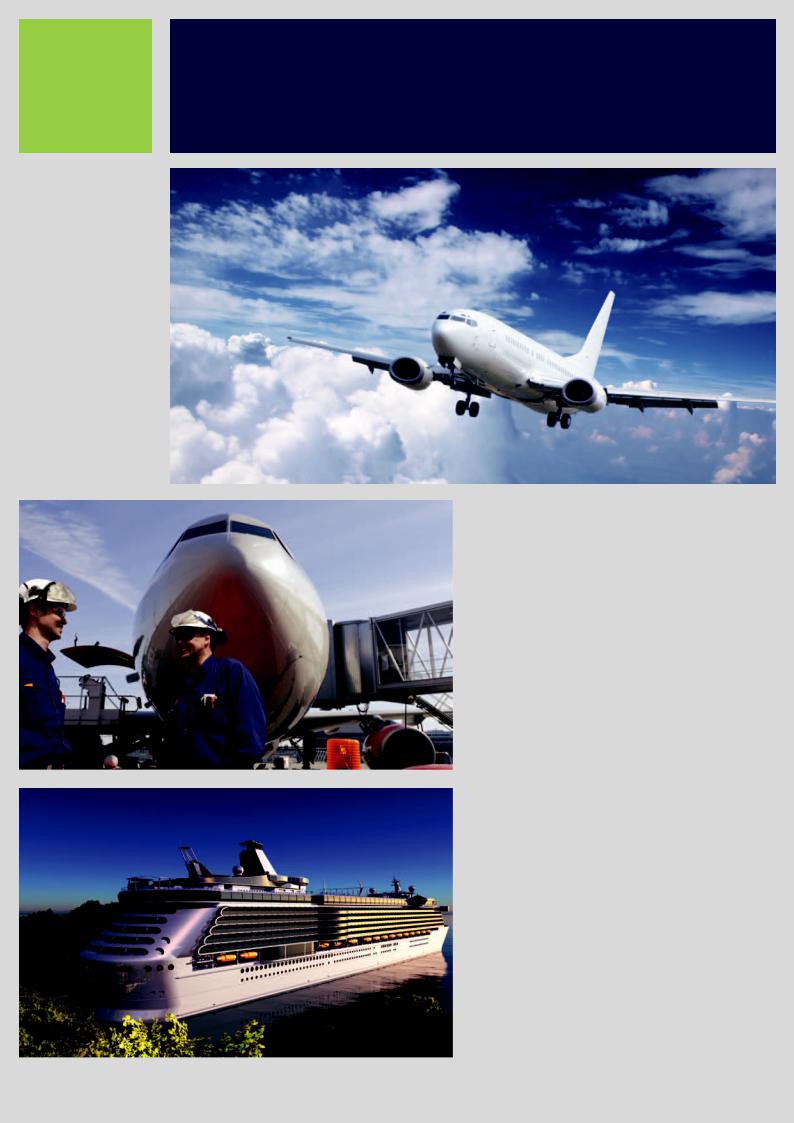
туризм
.pdf
The Authority on World Travel & Tourism
Travel &
Tourism 2011

Travel & Tourism 2011
Foreword
Chapter 1: Why Travel & Tourism?
Chapter 2: A Decade of Challenge and Change
Chapter 3: 2011; A Mixed Picture
Chapter 4: The Next Ten Years
Chapter 5: Making it Happen
© Copyright World Travel & Tourism Council 2011
USE OF MATERIAL IS AUTHORISED, PROVIDED SOURCE IS ACKNOWLEDGED

Foreword
Travel & Tourism is a truly global economic activity – one which takes place in destinations across the world, from leading capital cities and smaller towns and villages in rural and coastal areas, to some of the remotest points on the planet. It is one of the world’s largest industries, or economic sectors, contributing trillions of dollars annually to the global economy, creating jobs and wealth, generating exports, boosting taxes and stimulating capital investment.
Nearly 260 million jobs worldwide are supported by Travel & Tourism – either directly in the industry or in related sectors. And these jobs are vital not only for the livelihoods of those employed, but also for their families and the wider communities in host destinations. Today there are few people who have neither contributed to the growth of Travel & Tourism through their own spending, nor felt the impacts of others’ expenditure.
Over the past two decades, since the World Travel & Tourism (WTTC) was founded, substantial progress has been made in raising awareness of the importance of Travel & Tourism. But we still have a long way to go to get our message across clearly to all stakeholders.
WTTC is the global business leaders’ forum for Travel & Tourism and our Members are the Chairs, Presidents and Chief Executives of the world’s foremost Travel & Tourism companies, representing all sectors of the industry – from air transport and accommodation to catering, entertainment and recreation
– as well as related sectors. Our mission is to maximise the sustainable growth of Travel & Tourism and help ensure that the benefits are spread across countries and to all levels of the population.
Despite a whole host of challenges over the past decade – from terrorist attacks and health scares to natural disasters – international Travel & Tourism demand has shown phenomenal growth. And, while we will no doubt continue to face numerous, and unexpected, challenges in the future, our forecasts – as well as those of economic and industry experts generally – point to a further surge in demand over the coming decade, with competition intensifying to capture a share of the fastgrowing emerging markets.
This means that the focus of our attention and efforts must shift. We must leverage Travel & Tourism’s past accomplishments to build even greater awareness of the need to factor Travel & Tourism into all policy and decision-making in order to ensure that the growth is sustainable.
When managed responsibly, Travel & Tourism can be a significant catalyst for the economic and social transformation of less resource-rich countries and communities. In many small island states, for example, tourism provides the only feasible alternative to basic agriculture as a source of income for local residents. And, in an increasingly globalised world, Travel & Tourism is fundamental to international relations, business and cross-cultural understanding.
This first annual review of Travel & Tourism from WTTC contains some important messages.
We look forward to your support in communicating them widely to stakeholders from government, industry, the media and the wider community.
David Scowsill
President & CEO
World Travel & Tourism Council
Travel & Tourism 2011 |
|
1 |
|
|
|

1 Why Travel & Tourism?
Travel & Tourism is one of the world’s leading industries, or economic sectors, representing a major source of GDP, employment, exports and taxes. In 2011, the World Travel & Tourism Council (WTTC) expects it to contribute almost US$6 trillion to the global economy, or 9% of global gross domestic product (GDP).
travel & tourism contributeS us$6 trillion to the global economy, 9% of global GDP, AND SUPPORTS 260 MILLION JOBS WORLDWIDE
The rapid rise in global demand for Travel & Tourism over the past few decades has been spurred by the rise in living standards, in turn fuelled by growing wealth, coupled with the increased affordability of air travel. According to the World Tourism Organization (UNWTO), international arrivals worldwide have more than doubled since 1990, rising from 435 million
to 675 million in 2000, and to 940 million in 2010. And these figures do not take account of domestic tourism which, by all accounts, generates up to ten times more arrivals than international tourism.
More than just visitor spending
The impacts of Travel & Tourism run deep into our economies. It is not just about the money visitors spend on travel, accommodation, activities and souvenirs – visitor exports – which, in 2011, is expected to exceed US$1.2 trillion around the world. But, by its very nature, the industry stimulates the engagement and collaboration of communities, tourists, governments, local suppliers and businesses
throughout the supply chain. And the 260 million estimated people around the world whose jobs are supported by Travel & Tourism (100 million of whom work directly in the industry) all spend a proportion of their own income on goods and services from all parts of the economy. Furthermore, demand for Travel & Tourism – both international and domestic – stimulates investment. In 2011 4.5% of total capital investment, or some US$650 billion, will be driven by Travel & Tourism.
2 |
|
Travel & Tourism 2011 |
|
|
|

Travel & Tourism is one of the world’s largest industries accounting for 9% of global GDP. This is more than the automotive industry which accounts for 8.5%, and only slightly less than the banking sector which accounts for 11%.
GDP contribution by sector, 2011
12% |
|
|
10% |
|
|
8% |
|
|
6% |
|
|
4% |
|
|
2% |
|
|
0% |
|
|
Automotive |
Banking |
Tourism |
production |
|
|
ν Direct GDP
ν Total GDP Source: Oxford Economics
GDP contribution by sector, 2011
12% |
|
|
|
|
|
10% |
|
|
|
|
|
8% |
|
|
|
|
|
6% |
|
|
|
|
|
4% |
|
|
|
|
|
2% |
|
|
|
|
|
0% |
|
|
|
|
|
2000 |
2002 |
2004 |
2006 |
2008 |
2010 |
ν Automotive production |
|
|
|
||
ν Banking |
|
|
|
|
|
ν Tourism |
|
|
|
Source: Oxford Economics |
|
More significantly, while the last ten years have seen strong global growth helped by a rising share of the fast-growing high-tech industry, as well as rapid growth in service sectors such as banking and global finance, the next ten years are forecast to see a slower performance from these sectors. Continued growth in Travel & Tourism will therefore result in an increase in the sector’s relative share of GDP. In short, Travel & Tourism will become more important to the global economy over the next ten years.
Travel & Tourism 2011 |
|
3 |
|
|
|

Why Travel & Tourism?
Defining and Measuring Travel & Tourism
Measuring the size and growth of the Travel & Tourism sector around the world is challenging, but it is critical for an understanding of its economic contribution.
WTTC, in partnership with Oxford Economics, has developed a complex methodology for producing consistent, comprehensive and comparable estimates, incorporating and compatible with the Tourism Satellite Account: Recommended Methodological Framework
(TSA:RMF 2008) approved by the United Nations Statistics Division. It measures spending on Travel & Tourism by households, governments, businesses, overnight and same-day visitors, to fully capture the economic contribution of both domestic and international tourists, whether travelling for business or leisure.
Over the past 20 years, WTTC has continually reviewed and enhanced its methodology (details of which can be found in Appendix 1, developing a system for producing estimates for the economic contribution of Travel & Tourism to 181 countries, 20 regions and the world overall. Data for all countries can be accessed on www.wttc.org
These are not strictly Tourism Satellite Accounts (TSAs) – and are not intended to replace country TSAs – but the estimates are derived from official national TSA statistics, where available, as well as other published data, and are complemented by economic modelling, which allows for cross-country benchmarking. For those countries for which no relevant statistics are available, the importance of this research is that it provides a starting point for understanding the direct and indirect economic impact of Travel & Tourism and, ultimately, for better long-term planning.
DIRECT
TOTAL |
INDIRECT |
TOTAL |
|
|
INDUCED
TOTAL
A major strength of the research, in addition, is that it allows for timely comparisons across countries on a like- for-like basis, and notably for those countries that do not yet have the available resources to undertake full TSAs, which WTTC continues to endorse and encourage.
Travel & Tourism
as a catalyst for growth
Travel & Tourism is a dynamic industry which boosts economies by generating income, employment, investment and exports, thus stimulating economic growth. But it also generates valuable spin-off benefits, either by developing infrastructure that other industries can use or by creating positive publicity for individual countries and destinations.
Simply through its own existence, Travel & Tourism boosts trade, skills and investment in other unrelated industries. To highlight a few examples:
•A recent study commissioned by WTTC showed that business travel was responsible for one third of the growth in global trade over the past decade.
•Of the US$1.2 trillion of annual global foreign direct investment (FDI), around US$76 billion is for local infrastructure such as transport links, hotels and convention centres.1
•Many of the skills developed by Travel & Tourism training programmes, from high-end management to basic customer service, are transferable to other sectors of the economy. As their graduates find jobs across these different sectors, Travel & Tourism has a positive ‘spillover’ effect on productivity.
4 |
|
Travel & Tourism 2011 |
|
|
|

•The Travel & Tourism industry also plays a key economic role in facilitating international opportunities for work – important not only for highly skilled professionals but also for manual workers who repatriate at least part of their earnings back to their home countries and communities. There are some 214 million migrants across the world today 2 – up from 150 million in 2000 – and the remittances sent home by these migrant workers were estimated at over US$440 billion in 2010.3
•The demand for many products and services is known to depend in part on the overall impressions of the country from which
they come – and such ‘country-of-origin’ effects can be significantly enhanced and manipulated through Travel & Tourism. This helps countries to boost exports generally – eg Italian fashion or French fine wines – and to attract wider investment.
BUSINESS TRAVEL WAS RESPONSIBLE FOR ONE THIRD OF THE GROWTH IN GLOBAL TRADE OVER THE PAST DECADE
The social benefits of Travel & Tourism
Travel & Tourism also generates spin-off benefits of a social and cultural nature. The industry directly helps to keep, or to bring, families and social networks together. A significant proportion of all international trips – up to a third of all arrivals for some large developed markets – are to visit friends and/or relations (VFR travel).
In addition, Travel & Tourism indirectly promotes cultural heritage and global communication, helping to enhance understanding between people. This in turn can lead to improved international relations between governments, fostering world peace.
1Source: World Investment Prospects Survey, 2009-2011
2Source: International Organisation for Migration
3Migration and Remittances Factbook, 2011, World Bank
•The industry provides some of the most flexible employment and working practices found across the entire economy. Hotels and catering, for example, typically employ more women, ethnic minorities, older people and part-time workers than almost any other sector – a diversity reflecting the highly flexible nature of many jobs. Jobs can often be carried out in many different locations away from the conventional workplace, such as at home. For women, this can play an
important part in promoting gender equality – empowering women at all levels of society.
•Globally, more than 50% of people now live in cities, and forecasts predict this figure will rise to a staggering 75% by 2025.
This creates a big threat to the smaller, more remote communities. But Travel & Tourism can provide a lifeline to these same communities, allowing essential services and supplies to be delivered, as well as generating vital income from visitors.
•Travel & Tourism provides a vital source of income and employment in many developing countries around the world. As an example, Travel & Tourism directly or indirectly supports 76% of all jobs in Aruba, 31% in Belize and 27% in Namibia. Without this economic lifeline, millions more people would live in poverty in these countries, or be forced to leave their home countries in search of work.
•The major cultural differences between people around the world can, and often do, create tensions and conflicts. By enabling people to visit, study and work in other countries, Travel & Tourism builds vital bridges to help overcome these problems. Indirectly, it can also promote the exchange of cultures and global dialogue, which in turn fosters understanding between people, boosting national pride, helping to preserve and promote cultural heritage, and protect indigenous people and their way of life.
Travel & Tourism 2011 |
|
5 |
|
|
|

FOCUS
Key sectors
Aviation
Air transport lies at the heart of modern, globalised economies. Some 3 billion passengers and more than 50 million tonnes of freight are flown around the world every year. And about one third of the value of global trade in manufactured goods is transported by air.
Aviation is in itself one of the world’s most important economic sectors. Oxford Economics has estimated that over 5.5 million workers are employed directly in the industry worldwide and that, if aviation were a country, it would rank 21st in the world in terms of GDP – with its US$425 billion contribution considerably larger than that of some members of the G20 group of nations.
Aviation also generates further economic benefits. It enhances efficiencies through economies of scale, increased competition and innovation, and access to wider pools of human resources. In particular, the benefits to society of expenditure on research and development by the aerospace industry are very significant, adding 70 cents to GDP year after year for every dollar initially invested.
6 |
|
Travel & Tourism 2011 |
|
|
|

Cruise
Despite being hard hit by the global economic recession in 2008 and 2009, both in terms of passenger demand and global cruise value sales, the cruise sector has been one of the fastest-growing sectors of Travel & Tourism over the past ten years – and indeed over the last two to three decades. To illustrate the point, the average annual passenger growth rate for the (largely American) members of the Cruise Lines International Association (CLIA) has been more than 7.5%, reaching 14.8 million in 2010 (up 10% over 2009). This puts the total estimated cruise passenger count at more than 16 million worldwide.
While North America dominates the global cruise business, the share of other regions is increasing and Europe now accounts for more than 5 million cruise passengers annually, as well as showing much stronger value growth in the last five years. Industry experts believe the total number of Europeans taking cruises could more than double by 2020.
Global data for the economic impact of the cruise sector is hard to come by. However, recent research by the European Cruise Council estimates that, in 2010, the sector generated €14 billion in direct spending and accounted for nearly 300,000 jobs in the region. Less recent research in the Caribbean suggests
that the sector generated 41,500 jobs in 2006 with US$600 million in wage income to Caribbean residents.4
4 Bahamas Real Estate Association (BREA), 2006
Hospitality
The economic reach of the hospitality sector is uncommonly broad: its supply chain generates business activity for many other parts of the economy and, in particular, for the retail, recreation, transport and restaurant sectors. Hotels also provide a forum for business meetings, trade shows and conventions that are an important catalyst of economic growth.
Hospitality is a major global growth industry. There are now some 12.7 million hotel rooms around the world, including 4.9 million in the USA and 3.9 million in Europe. In total, the number of new rooms planned or under development (1.3 million) equates to more than 7% of the existing worldwide stock, while in the Middle East and Africa – which together are responsible for almost half the new rooms under construction – the share is more than 20%.
Jobs in the hospitality sector are occasionally considered to be inferior or ‘non-career’ posts. In reality, to keep any large hotel operating round the clock takes not only receptionists and room attendants, but also a diverse team of highly skilled specialists with backgrounds ranging from accountancy to information technology.
At the same time, hospitality is an important employer as it offers a wide range of fulland part-time jobs for young people, first-time job seekers, minority groups, retired people, and working mothers. Research has shown that, in times of economic recession, hospitality can also take up unemployment faster than almost any other sector.
Travel & Tourism 2011 |
|
7 |
|
|
|

2 |
A Decade of |
Challenge and Change |
Travel & Tourism has clearly demonstrated its resilience over the past decade. Although the industry has weathered its fair share of disasters – from terrorist attacks, pandemics and other health scares, to a whole host
of natural disasters including earthquakes and tsunamis, floods, cyclones and forest fires – the negative impact has usually been localised and short term.
This is highlighted by the growth in international arrivals worldwide from 2000 to 2010, as recorded by the World Tourism Organization (UNWTO). Over the ten-year period, average annual growth was 3.4% – from 674 million in 2000 to 940 million in 2010 – with emerging markets (5.6%) strongly outpacing advanced economies (1.8%).
International tourist arrivals, 2000-2010
1000 |
|
|
|
|
|
|
|
|
|
|
800 |
|
|
|
|
|
|
|
|
|
|
600 |
|
|
|
|
|
|
|
|
|
|
400 |
|
|
|
|
|
|
|
|
|
|
2000 |
2001 |
2002 |
2003 |
2004 |
2005 |
2006 |
2007 |
2008 |
2009 |
2010 |
ν Arrivals (mn) |
Source: World Tourism Organization (UNWTO) |
Total arrivals volume declined in only three years during the decade.
•2001: the devastating terrorist attack on
11 September (9/11) in the USA had a major impact on global demand in the last quarter of 2011, but the final outcome was a year of stagnation rather than real decline (-0.1%).
•2003: a relatively modest 1.6% fall in arrivals was due to the combined effect of three significant factors: the Iraq crisis, the SARS outbreak and a persistently weak global economy.
•2009: the global economic recession that started in the second half of 2008 resulted in a 3.8% decline in arrivals worldwide the following year.
8 |
|
Travel & Tourism 2011 |
|
|
|
